Sharp N9000 Series 4K HDR TV Review
Sharp LC-70N9100U, Sharp LC-65N9000U
4K Aquos TV, 4K Media Player and Receiver included, HDR, Quantum Dot
by Robert Wiley, Senior Editor
Hisense-Sharp Takeover
Hisense, a large Chinese manufacturer licensed the Sharp name in June of 2015. Hisense is not a well known brand in the U.S., but it is in China, where the company has the number 1 market share in units sold. It's also reportedly #3 globally in units sold with over 16 million TVs produced. Hisense is focusing on low priced models as well as high quality featured TVs all the way up to THX certification in its bid to gain U.S. Market share. Hisense purchased the Sharp brand and the Mexico assembly facility in a $23M deal. The Sharp models will purportedly still use the Sharp LCD panels in their production.
Picture Quality
The N9000 series bumps the resolution to 4K UHD, and has solid picture quality with a good front and center viewing black levels and color saturation. HD 720P, 1080p signals and lower are upconverted by the Revelation upscaler. This is one of the most important elements of any 4K TV as there is still little available content. Most of what we watch is still 1080p (if we're lucky) but mostly 720p and 480p. The front glass panel adds nice depth to images where plexi often fails to deliver.
Quatum Dot Technology Included
Spectros is Sharp's name for the Quantum Dot spec. How does Quantum Dot technology work? The Nano crystal layer (called the QDEF layer) is a stack of ultra thin film located between the LCDs (liquid crystals) or LEDs and the front protective glass or plexi layer. The benefits of the technology are a wider color gamut (more colors) produced by better disbursement through the Nano Crystal Diffuser Film. Think of the Nano Cystal layer as a color converter which assists the LCDs in creating more colors. It produced a cleaner, clearer and more defined color representation especially in the greens and yellows. With a 4K UHD signal I would say the color production is 5% to 10% better.
High Dynamic Range
The big focus TV feature for 2016/2017 is HDR (High Dynamic Range). HDR extends the range that a pixel in an LCD TV can show. This applies to the brightness and luminosity of images. Contrast is enhanced by increased brightness rather than deeper blacks. Rather than just increase the brightness of the picture overall though, the real purpose of HDR is to increase contrast in various image areas of the picture. It improves the presentation in the brighter parts of the picture and this creates more contrast with surrounding darker parts of the picture. Since picture contrast is one of the primary features in improving perceived depth, HDR is considered a major picture quality improvement even though it may not increase the overall contrast of the panel a lot. Bright colors receive enhanced purity. A good HDR image will show better shadow detail, and the scenes that you will notice the most are those with light illuminating images, especially outside sunlight effects, or a room that has sunlight coming in through a window and illuminating parts of the room. HDR content is and will be in short supply for a while.
Colors and black levels do degrade at side angles starting at 18 degrees off center. Brightness levels very good. There is some perceived lack of depth in on-screen images.
Full Array Local Dimming
Both of the N9000U models have the expensive addition of full array local dimming. The full array option is more complete, giving the viewer better contrast in more refined areas of the screen. Both models have some benefit of the dimming exercise and are controlled by (LED backlight) zonal manipulation in such a way that they can help increase contrast in various areas of on-screen images. In a 65”+ TV they are especially beneficial. We give the N9000U an average rating in local dimming processing and presentation.

A stunning 4K image displayed on the N9000.
Features
The top of the line N9000 series is a serious quality TV with QD, 4K, HDR capability. It has a built in streaming Apps selection including the usual suspects that you use most like Netflix, Amazon on Demand, and You Tube. Built in Dual Band Wifi. An Apps store and web browser. And a media player/receiver. It also has the Sharp “Aquomotion” designation which manipulates the backlight in order to show a perceived smoother picture (increased Hz rate designation). Gaming input lag is very average on this TV, not up to par with mid range Samsung, LG and Vizio models.
Wallpaper Mode
This is an interesting feature that doesn't add much value to the TV, but we see it as something fun. Sharp’s claimed exclusive Wallpaper Mode gives users the ability to choose any image they would like for the screen to display when the TV is OFF. They claim the energy levels are extremely low and the brightness simulates museum conditions. This isn't going to be a selling point for the TV, but it's a neat idea that could provide some fun results during dinner parties.

Sharp's new Android TV platform is fast with lots of options
Price/Value
The 70N9100 sells for a premium price of around $3199. The 65N9000U goes for under $3000. These are both advanced TVs with lots of extra high end features. HDR, Quantum Dot, a front glass panel (rather than plexi-glass), upgraded remote control, separate media receiver, full array local dimming, and a wide color gamut.
(A note about our reviews. Our professional reviewers begin our reviews with our initial impressions about quality of picture and features inclusion, then we add specifications, then value and pricing information, and finally, ratings. When our reviews contain an overall rating, they are complete. Thank you for reading!)
 |
Having reviewed and written about Television Technology for over 10 years, Wiley never tires of researching the newest qualitative trends related to the technology. Most people do not get excited about possibilities behind the latest video engine... Wiley does. Read more about Robert |








